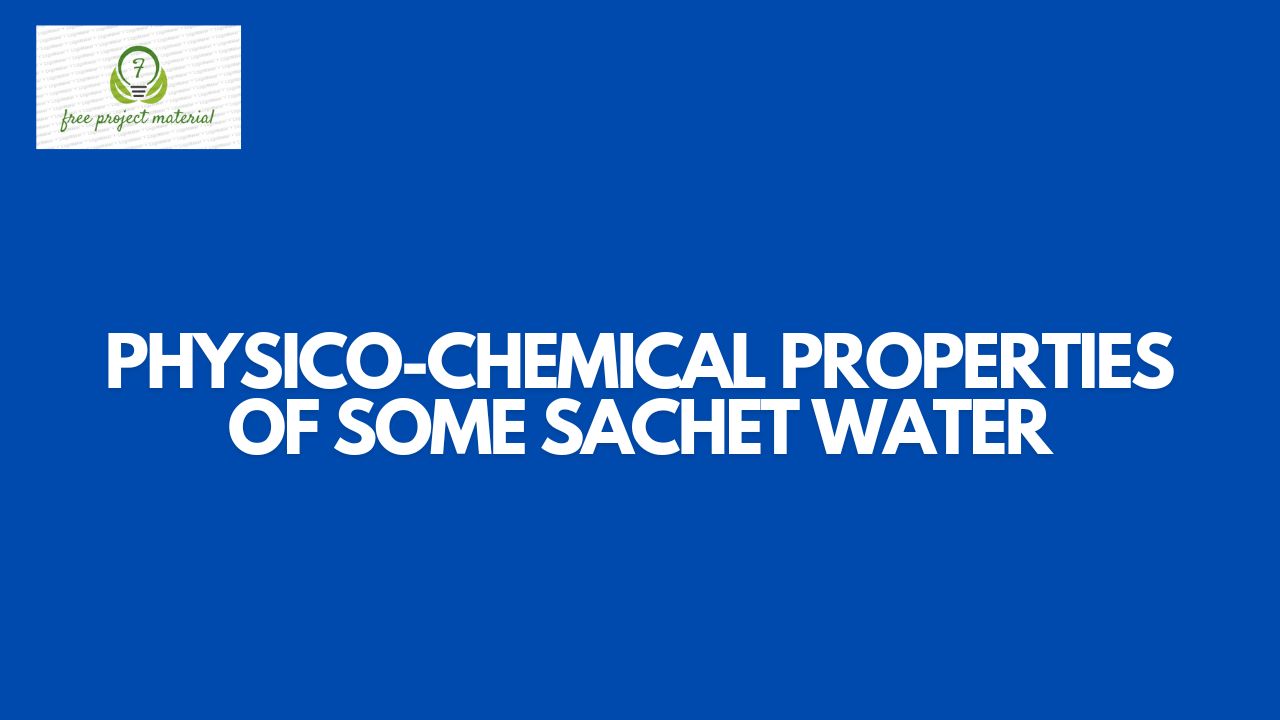ABSTRACT
Evaluation of physicochemical properties of some different commercial sachets water was carried out using recommend standard methods. The result revealed that the pH, Temperature, Electrical conductivity, Alkalinity and Acidity were found to be within WHO desirable limits However, TDS, TSS, DO, BOD, SO42-, CL–, and NO3– ions values were found to be within WHO maximum permissible limit. This results serves as a data base for some commercial sachet water sold in Uyo metropolis.
TABLE OF CONTENTS
Cover Page
Title page – – – – – – – – – – i
Certification – – – – – – – – – ii
Dedications – – – – – – – – – iii
Acknowledgment s – – – – – – – – iv
Abstract – – – – – – – – – – -v
Tables of contents – – – – – – – – vi-ix
List of Tables illustration – – – – – – – 58-59
CHAPTER ONE: INTRODUCTION
- Background of the study – – – – – – – 1-7
- Aim and objective of the study — – – – – – 7-8
- Scope and Limitation of the study – – – – – 8
- Definition of terms – – – – – – – 8-10
CHAPTER TWO
2.1 Production of sachet drinking water — – – – 11-15
2.2 quality of sachet water – – – – – – – 15-27
2.3 Benefits of Drinking Sachet Water – – – – – 27-29
2.4 Physical Properties of Water – – – – – – 29-31
2.5 Physicochemical Indicators of water Quality – – – – 31-33
2.6 Characteristics of Water – – – – – – – 33
2.6.1 Taste and Odour – – – – – – – – 33-35
- 6.2 Colour – – – – – – – – – 35
2.6.3 Electrical Conductivity (EC) – – – – – – 36
2.6.4 Total Suspended (TSS) – – – – – – – 36-37
2.6.5 Total Dissolved Solid (TDS) – – – – – – 37-39
2.6.6 Temperature – – – – – – – – 39
2.7 Chemical Properties of Water – – – – – 40
2.7.1 PH – – – – – – – – – – -40
2.7.2 Dissolved Oxygen (DO) – – – – – – – 41-43
2.7.3 Biological Oxygen Demand (BOD) – – – – – 43-45
2.7.4 Alkalinity – – – – – – – – – 45-46
2.7.5 Sulphate – – – – – – – – – 46-47
2.7.6 Acidity – – – – – – – – – 47-48
2.7.7 Nitrates – – – – – – – – – 48-49
2.7.8 Chlorides – – – – – – – – – 50
CHAPTER THREE: MATERIAL AND METHODS
3.0 Material and Methods – – – – – – -51
3.1 Sample Collection and Preparation – – – – – 51
3.3 Method of Physical Properties – – – – – – 51
3.3.1 Determination of Temperature – – – – – 52
3.3.2 Determination of Total Suspended Solid (TSS) – – – 52
3.3.3 Determination of Total Dissolved solid (TDS) – – – 53
3.3.4 Determination of Electrical Conductivity (EC) – – – 53
3.4 Method of Chemical Properties – – – – – – 54
3.4.1 Determination of pH – – – – – – 54
3.4.2 Determination of Dissolved Oxygen – – – – 54
3.4.5 Determine of Biological Oxygen Demand – – – – 55
3.4.6 Determination of Nitrate Content – – – – – 55-56
3.4.7 Determination of Sulphate – – – – – 56
3.4.8 Determination of Alkalinity — – – – – 56
3.4.9 Determination of Chloride – – – – – – 57
CHAPTER FOUR: RESULT AND DISCUSSION
4.0 Result and Discussion – – – – – – – 58
4.1 Result – – – – – – – – – 58-59
4.2 Discussion – – – – – – – – – 59-63
CHAPTER FIVE : CONCLUSION AND RECOMMENDATION
5.0 Conclusion and Recommendation – – – – – 64
5.1 Conclusion – – – – – – – – – 64
5.2 Recommendation – – – – – – – – 65
References
CHAPTER ONE
1.1 BACKGROUND OF STUDY
Water is one of most important natural resources known on earth (Ojo et al., 2005). Water of good quality is important to human physiology and man’s continued existence depends very much on its availability (Limikanra, 1999). Before water can be described as potable as potable, it has to comply with certain physical, chemical and microbiology standards, which are designed to ensure that the water is potable and safe for drinking. Potable water is defined as water that is free from contaminants, such has disease causing microorganism and harmful chemical substance (Ihekorony and Ngoddy, 1995).
The importance of potable water supply in the socioeconomic life of the public cannot be over emphasized. Often, source and potable water supply reflects on the health conditions of communities. Water meant for consumption should be free from pollution, acceptable and safe. Indeed the quality of the water sources should not exceed the maximum limits specified in the water quality guideline (Obi et al., 2004). Sachet drinking water was introduced into the Nigerian market as a less expensive means of accessing drinking water than bottled water (Ogundipe, 2008). There has been countless number of diseases outbreak and poisoning around the studied on the quality Analysis of sachet water have reported violation of international quality standards. According to the Institute of public Analysis of Nigeria (IPAN) 50% of the sachet water sold in the streets of Lagos may not be fit for consumption (Oshibanjo et al; 2000).
Sachet water, the most common form of packaged water in rural and urban communities of developing nations, when properly recognized and improved, would offer great hope in achieving sustainable development (Dada, 2011). According to Deda (2011), improving upon existing processes in developing countries could help achieve this objective, and end way by which existing processes could be improve to adopt the Hazard Analysis critical control point (HACCP) system (Cheabu & Ephraim, 2014). Taking cognizance of the emergence of the sachet drinking water industry and making the control points within production stages, water quality and maintenance processes could be relevant to increasing access to potable water in developing countries. Sachet water is considered as the late, low cost technological evolution of vended water (Cheabu & Ephraim 2014); and as a cheap, potable and omnipresent solution for reducing the gap between safe and unhealthy water access within cities in these countries (Little, 2015). Good quality water is odourless, colourless, tasteless, and free from faecal pollution. A reliable supply of clean wholesome water is highly essential in a bid to promoting health living among the inhabitants of a defined geographical region. Safe and potable water supplies in urban centres in Nigeria are still inadequate in spite of four decades of independence and several efforts from various governments the standard industrialized world model fro delivering of safe drinking water and sanitation technology is however, not affordable in most of the developing world. Consequently, given the renewed global commitments towards the millennium Development Goals (MDG) marked for 2015 the importance and contribution of locally sourced low-cost alternative drinking water schemes to sustainable access in rural and urban settings of development nations cannot be overemphasized (Dada, 2007).
One of such local intervention in Nigeria where public water supply is unreliable is drinking water sold in polythene sachets. Water in sachets is readily available and affordable, but there are concerns about its purity. The integrity of the hygienic environment and conditions where the majority of the water in sachets are produced has been questioned. Apart from environment contaminates, contamination from improper vendor handling also poses threats to the health of the ignorant consumers who drink often times without any proper cleaning of the sachets. Previous studied have related diseased continued to be one the major health problems globally (Ihekoronye and Ngoddy, 1985).
The importance of packaged drinking water gained prominence in India in the late nineties when the Bureau of Indian standards in collaboration with the health ministry of India drafted rules and regulations as part of the prevention of Food Adulteration Act to ensure safety in the industry (Dada, 2011). In Nigeria, the government asserted that the introduction of sachet water into the economy was one of the most successful poverty alleviation endeavors that had been attempted since the country gained independence (Dada, 2007). The emergence of sachet water as a cheaper option to bottled water in Nigeria was recorded by Okogia (2007). The Nigeria government entrusted into the hands of the Nigeria standards Borders (now Nigeria standard Authority) the authority to ensure safety and sanity of sachet drinking water for three reasons. First, sachet drinking water is affordable to the ordinary Nigerians; second, large portions of the populace reply on sachet drinking water and third, municipals have been unreliable in providing safe drinking water to the populace. One of the important stages in the sachet water industry is the production stage where water is processed and bagged production requires a water sachet filling machine. The source of raw material is municipal water or water from” upgrade wells” usually referred to as borehole water. Other production processes include UV sterilization, polyethylene bagformimg, filling and sealing, among others. Within the industry, and through the reduce health care cost, among others,. Various literature have dealt therefor with sachet water quality in Nigeria (Little, 2015; Stoler et al., 2012).
1.2 AIM AND OBJECTIVE OF STUDY
The main objectives of this research was therefore to determine the physic-chemical properties of sachet water.
Specific Objectives:
The specific objectives included:
- To assess bacteriological contamination levels of sachet water.
- To observe and characterize physical properties of sachet water during prolonged storage scenarios.
- To create awareness amongst potential and target communities of sachet water users.
1.3 SCOPE AND LIMITATION OF THE STUDY
The design of this research project is to investigate and determine the physic-chemical properties of sachet water.
Due to time and lack of facilities also financial constraints, this research project was limited to physio-chemical properties of sachet water.
1.4 DEFINITION OF TERMS
Physico-chemical: Relating to physics and chemistry or to physical chemistry. Physico- chemical properties are the intrinsic physical and chemical characteristics of a substance. These include appearance, boiling point, density, volatility, water solubility and flammability etc.
Properties: A chemical property is any of a material’s properties that becomes evident during, or after, a chemical reaction; that is, any quality that can be established only by changing a substance’s chemical identity.
Sachet Water: sachet water or pure water, 500-ml heat-sealed plastic sleeves of drinking water, has become an immensely popular form of packed drinking water in the face of urban drinking water shortages in western Africa.
Water: A colourless, transparent , odourless liquid that forms the seas, lakes, rivers, and rain and is the basis of the fluids of living organisms.
Composition: The way something whole or a mixture is made up. The action of putting thing together; formation or construction, Composition is another word for writing the act of writing or the piece of writing that results. It also refers to what something is made of writing classes are often called composition classes



